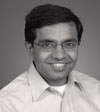Marc Andreessen changed my vote during a conversation we had at the Copa (I mean of course the Cafe Copa in Palo Alto, not the-hottest-spot-north-of-Havana Copa). Between sips of my soy-decaf-mocha, I lazily referred to the Web 2.0 bubble, when Marc challenged me with "What bubble?"
 This struck me as an important question for a VC like me to seriously consider, not only because Marc has been right more than once in his life, but also because he is twice my size.
This struck me as an important question for a VC like me to seriously consider, not only because Marc has been right more than once in his life, but also because he is twice my size. I blabbered on about the web2.0 frenzy, after which Marc politely observed, with unassailable logic, that frenzies do not imply bubbles. Domestic internet IPO's are sucking up little if any public capital, and U.S. venture capital investment in internet companies actually declined in Q3 (which is backed up Thomson Venture Economics).
Marc was right again. Suffering from VC-herd-mentality, I had confused the excitement around today's new technologies with the excessive IPO march of Web1.0. All we have now is some soap--to blow a bubble we'd need a stream of hot, airy IPO's. (if only...) True, anecdotal data alert us to a coming wave of venture capital that will indiscriminately flow into every startup touting AJAX, wikis, RSS, tags, Open Source and consumer content. But over-funded ventures do not always beget IPO's--remember Go, Pointcast, Napster and Friendster?
So (in a further tribute to Godel, Escher and Bach) I assert that all that bubble spotting is itself just another bubble. The much more important question is whether there is substance to the frenzy. Many of us, including Andreessen, seem to think so, but let's save all the reasons for an O'Reilly conference, not a Saturday 2AM blog.
I have one last question to pose here, and to ask Marc next time I see him:
Why now? Why did all these new technologies seem to emerge in 2005, in a surprisingly sudden end to the internet's first Dark Ages? How much of it springs from the finanical success of Google, or the integraton ease of XML? Or should we expect this rate of innovation to only increase as we accelerate inexorably toward Ray Kurzweil's singularity?
I posed this question to my fellow panelists on a VC podcast, and the only answer I got was "2002"--that is, the year when programmers had nothing to do but dream up new stuff. (Great, another reason for Republican think tanks to advocate unemployment.)
So returning to IM speak... IYHO, iz w2 1 tym tng o d nrmL st8 of INOv8n?
CUL8R!









